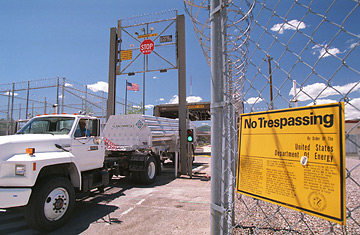
Los Alamos National Laboratory in Los Alamos, NM.
A senior U.S. official had to be pulled out of a White House meeting to hear the bad news: highly classified e-mail dealing with the composition of America's atomic weapons had illegally been sent via non-secured networks to members of the board of Los Alamos National Security, LLC (LANS), the company that manages America's nuclear lab in New Mexico. After it was discovered, the fact that the message had passed electronically from person to person without safeguards was quickly designated an "IMI-1" violation, the most serious breach of U.S. national security. LANS could face financial penalties if found responsible for the violation.
Upon learning of the Jan. 19, 2007, incident, government officials immediately ordered the seizure of computers that had sent or received the super-sensitive information. An inquiry was launched and a classified damage assessment completed last month. Weapons data does not appear to have fallen into enemy hands. But the extent to which classified nuclear secrets has remained on servers along various insecure Internet pathways remains an open—and troubling—question.
The incident is the latest embarrassment in a 10-year roll of highly publicized security lapses at the storied lab. The latest one to attract national attention occurred last fall, when New Mexico police stumbled on 1,500 highly classified nuclear weapons designs stashed in a trailer park near the lab along with paraphernalia to manufacture methamphetamine.
The January "IMI-1" incident could prove at least as embarrassing because it was connected with LANS board members, some of the very people responsible for fixing the security problems at Los Alamos that some critics have labeled the worst in the U.S. government. Until now the episode has remained a closely guarded secret. Since January Energy Secretary Samuel Bodman, whose department is responsible for Los Alamos, has given hours of testimony to Congress detailing security problems at the lab, without ever mentioning the January incident.
But now, both John Dingell, chairman of the powerful House Energy and Commerce Committee, and Bart Stupak, chairman of the panel's oversight subcommittee, have indicated that they intend to raise pointed questions about the episode directly with Secretary Bodman. Dingell told TIME: "Despite multiple recent appearances before our Committee, many officials with specific knowledge of this security breach never informed us, and apparently presumed that taxpayers should be left in the dark."
Bodman, deputy Energy Secretary Clay Sell and other senior officials have all given testimony since Jan. 19 about the importance of security at Los Alamos, offering assurances that improvements would be made at the leaky lab. Referring to the reams of classified Los Alamos documents found in the New Mexico trailer park last year, Lab director Michael Anastasio told lawmakers, "My board finds [this incident] totally unacceptable... They're going to hold me accountable to fix this." Even as Anastasio spoke, some of the 11 members of the LANS board that manages Los Alamos were cooperating with an investigation of the undisclosed Jan. 19 security breach.
The sensitive weapons message originated on the laptop of Harold P. Smith, an LANS board consultant and former Pentagon atomic weapons adviser, who sent it to at least two other members of the board, sources told TIME. Those two then relayed the material to at least three additional LANS board members. Only then was the alarm sounded. After computers involved in the incident were seized, technical experts reportedly purged University of California servers that may have relayed the secret data. But it remained perplexingly unclear whether some of the highly classified weapons information might still be lurking on servers or along other Internet routes used in the transmissions.
